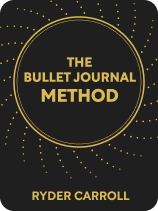

This article is an excerpt from the Shortform book guide to "The Bullet Journal Method" by Ryder Carroll. Shortform has the world's best summaries and analyses of books you should be reading.
Like this article? Sign up for a free trial here .
Are you feeling like you’re stuck in a rut? Do you want to know how to get inspired again?
If you’re stuck in a rut, feel demotivated, or uninspired, try bullet journaling. Keeping a bullet journal can help you explore every aspect of your problems in order to find solutions. It can also divert your attention to another project, which is a proven way to find inspiration.
Here’s how to use bullet journaling to rekindle your inspiration.
Finding Inspiration
When it comes to productivity, Ryder Carroll, the author of The Bullet Journal Method, argues that the right tools can teach us how to get inspired and pick up momentum when we feel stuck. When working toward our goals, it’s common to feel as if we’re not moving forward due to things like lack of motivation or imperceptible progress. For example, while training for a marathon, you may begin to feel stuck when you don’t see consistent progress in your mile time.
(Shortform note: In addition to preventing us from reaching our goals, feeling stuck can have negative psychological consequences. In particular, feelings of stagnation often mask more severe feelings of anxiety. They can also cause irritability, lethargy, frustration, or even numbness. What’s more, feeling stuck can worsen our tendency to procrastinate because we desperately want to escape our difficult feelings so focus on more pleasurable things.)
The Bullet Journal Solution
Carroll recommends two strategies for finding inspiration and getting unstuck. The first is to explain your problem or challenge to someone else. By describing your problem in detail to another person, you’ll likely begin to see it from a different perspective and uncover potential solutions.
However, because there may not always be someone available to talk to, Carroll suggests using your journal to recreate the experience. To do this, begin a new customized section and pretend to write a letter to someone—whomever you feel like. As you write, take time to explain your problem as if they’re there in front of you. Importantly, Carroll says you should assume the person has limited information so that you’re forced to describe every aspect of the problem. Talk about what it is and why it’s happening, the solutions you have and haven’t tried, and what you want the outcome to be.
The second of Carroll’s strategies is to divert your attention from your current problem to a mini-project that can inspire fresh ideas and motivation. He says the mini-project should be related to something you’re curious about (rather than an obligation), unrelated to your current problem or project, and possible to complete in two weeks or less. To plan out the mini-project, Carroll advises that you choose a goal from your goals-focused customized section and break it down just as he described when discussing continual improvement.
(Shortform note: Neuroscience research seems to support Carroll’s recommendation to divert your attention to find inspiration. According to experts, the brain thrives on wandering into new and unexpected ideas and experiences. This is because the more information you expose to your brain, the more connections it can make. By temporarily shifting gears and focusing on an entirely different project, you’re giving your brain the opportunity to stumble into innovative ideas.)
| Talking Your Way to a Solution Others disagree with Carroll’s claim that you can recreate the experience of explaining a problem to someone by writing in your journal. For instance, in Consciousness Explained, cognitive philosopher Daniel Dennett argues that simply thinking about problems isn’t as effective as talking about them out loud. He theorizes that the reason for this is that thinking doesn’t engage as many parts of the brain as speaking, and therefore you’re less likely to come up with solutions without real discussion. Research in the field of neuroscience provides some support for this theory. During conversations, our brains experience neurochemical reactions that change our body’s chemistry. What’s more, we can influence each other’s nervous systems in a positive way, increasing understanding, trust, compassion, and cooperation. In other words, by having conversations with others, we can create an environment that’s highly conducive to problem-solving. This may mean that Carroll’s journaling alternative won’t be as effective as conversing with a real person. |

———End of Preview———
Like what you just read? Read the rest of the world's best book summary and analysis of Ryder Carroll's "The Bullet Journal Method" at Shortform .
Here's what you'll find in our full The Bullet Journal Method summary :
- A comprehensive guide to using the Bullet Journal Method
- How to maintain a journaling practice that can improve your overall quality of life
- How to extend the method beyond productivity to a practice in mindfulness






